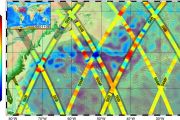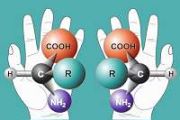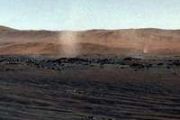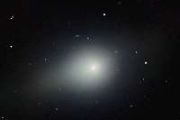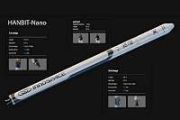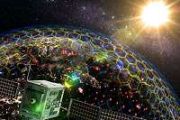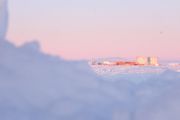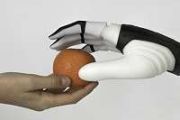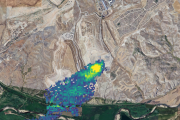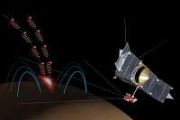
Copernical Team
New Seismic Data Reveals Daily Meteorite Impacts on Mars
 An international team of researchers, co-led by ETH Zurich and Imperial College London, has derived the first estimate of global meteorite impacts on Mars using seismic data. Their findings indicate between 280 to 360 meteorites strike the planet each year, forming impact craters greater than 8 meters (about 26 feet) across. Geraldine Zenhaeusern, who co-led the study, commented, "This rate was
An international team of researchers, co-led by ETH Zurich and Imperial College London, has derived the first estimate of global meteorite impacts on Mars using seismic data. Their findings indicate between 280 to 360 meteorites strike the planet each year, forming impact craters greater than 8 meters (about 26 feet) across. Geraldine Zenhaeusern, who co-led the study, commented, "This rate was InSight data reveals Mars hit by more meteoroids than previously estimated
 NASA's Mars InSight Lander may have completed its mission, but data from the robotic explorer continues to reveal new seismic discoveries. Recent findings suggest that Mars experiences meteoroid impacts more frequently than previously believed.
A study led by a researcher from Brown University indicates that Mars is bombarded by space rocks at rates two to ten times higher than earlier est
NASA's Mars InSight Lander may have completed its mission, but data from the robotic explorer continues to reveal new seismic discoveries. Recent findings suggest that Mars experiences meteoroid impacts more frequently than previously believed.
A study led by a researcher from Brown University indicates that Mars is bombarded by space rocks at rates two to ten times higher than earlier est Martian Meteorite Impacts Provide a 'Cosmic Clock' for Planetary Dating
 Seismic signals indicate that Mars is hit by approximately 300 basketball-sized meteorites annually, offering a new method for dating planetary surfaces.
New research led by scientists at Imperial College London and ETH Zurich, as part of NASA's InSight mission, reveals the frequency of 'marsquakes' caused by meteorite impacts on Mars. The study found that Mars experiences between 280 and
Seismic signals indicate that Mars is hit by approximately 300 basketball-sized meteorites annually, offering a new method for dating planetary surfaces.
New research led by scientists at Imperial College London and ETH Zurich, as part of NASA's InSight mission, reveals the frequency of 'marsquakes' caused by meteorite impacts on Mars. The study found that Mars experiences between 280 and China hauls back nearly 2 kilograms of lunar samples from s far side
 A total of 1,935.3 grams of lunar samples were retrieved by China's Chang'e 6 robotic probe from the moon's far side, the China National Space Administration announced on Friday morning, as the space authority handed over the scientifically invaluable substances to scientists.
The weight of the samples, the most asked question by science and space enthusiasts over the past two days, was re
A total of 1,935.3 grams of lunar samples were retrieved by China's Chang'e 6 robotic probe from the moon's far side, the China National Space Administration announced on Friday morning, as the space authority handed over the scientifically invaluable substances to scientists.
The weight of the samples, the most asked question by science and space enthusiasts over the past two days, was re NASA Explores the Potential of Fungi to Grow Space Habitats
 As NASA prepares for extended missions to the Moon and Mars, a newly selected concept aims to "grow" habitats using fungi for future explorers. Researchers at NASA Ames Research Center in California's Silicon Valley have received funding under NASA's Innovative Advanced Concepts (NIAC) program to advance their habitat research.
The Phase III NIAC award provides $2 million over two years to
As NASA prepares for extended missions to the Moon and Mars, a newly selected concept aims to "grow" habitats using fungi for future explorers. Researchers at NASA Ames Research Center in California's Silicon Valley have received funding under NASA's Innovative Advanced Concepts (NIAC) program to advance their habitat research.
The Phase III NIAC award provides $2 million over two years to SSC and Firefly Aerospace plan joint satellite launches from Esrange
 Swedish Space Corporation (SSC) and U.S. space transportation company Firefly Aerospace have entered into a collaborative agreement to launch satellites using Firefly's Alpha rocket from Esrange Space Center in Sweden, starting in 2026. This partnership aims to establish a new orbital launch service in Europe, utilizing a flight-proven launch vehicle to support commercial, civil, and defense sec
Swedish Space Corporation (SSC) and U.S. space transportation company Firefly Aerospace have entered into a collaborative agreement to launch satellites using Firefly's Alpha rocket from Esrange Space Center in Sweden, starting in 2026. This partnership aims to establish a new orbital launch service in Europe, utilizing a flight-proven launch vehicle to support commercial, civil, and defense sec Proba-3 tests formation flying systems on Earth
 The two Proba-3 satellites were positioned facing each other in a cleanroom, with cameras, LEDs, a laser, and shadow sensors activated sequentially to test the systems that will allow the pair to sense their precise positions relative to each other. This precision alignment is critical for their mission, aiming to achieve an alignment accuracy down to a single millimeter.
When two satellit
The two Proba-3 satellites were positioned facing each other in a cleanroom, with cameras, LEDs, a laser, and shadow sensors activated sequentially to test the systems that will allow the pair to sense their precise positions relative to each other. This precision alignment is critical for their mission, aiming to achieve an alignment accuracy down to a single millimeter.
When two satellit The science behind splashdown
 For about 15 minutes on July 21, 1961, American astronaut Gus Grissom felt at the top of the world - and indeed he was.
Grissom crewed the Liberty Bell 7 mission, a ballistic test flight that launched him through the atmosphere from a rocket. During the test, he sat inside a small capsule and reached a peak of over 100 miles up before splashing down in the Atlantic Ocean.
A Navy ship
For about 15 minutes on July 21, 1961, American astronaut Gus Grissom felt at the top of the world - and indeed he was.
Grissom crewed the Liberty Bell 7 mission, a ballistic test flight that launched him through the atmosphere from a rocket. During the test, he sat inside a small capsule and reached a peak of over 100 miles up before splashing down in the Atlantic Ocean.
A Navy ship Space Systems Accelerated by Northrop Grumman
 The speed of getting to space relies on more than just the thrust of a rocket. Before any countdown begins, satellite systems must be designed, manufactured, and tested to ensure they meet the unique needs of each mission. These customizable solutions, from well-crafted payloads to configurable high-volume constellations, deliver critical capabilities to keep the nation safe.
The rapid pac
The speed of getting to space relies on more than just the thrust of a rocket. Before any countdown begins, satellite systems must be designed, manufactured, and tested to ensure they meet the unique needs of each mission. These customizable solutions, from well-crafted payloads to configurable high-volume constellations, deliver critical capabilities to keep the nation safe.
The rapid pac Chang'e 6 mission raises potential for China-US space cooperation
 China's remarkable achievement of retrieving the first-ever samples from the far side of the moon has sparked discussions about the United States' strategy of excluding China from space projects. Experts are urging the US to consider inclusion over exclusion.
The Chang'e 6 probe returned to Earth on Tuesday with rock and soil samples from the lunar far side, a region that constantly faces
China's remarkable achievement of retrieving the first-ever samples from the far side of the moon has sparked discussions about the United States' strategy of excluding China from space projects. Experts are urging the US to consider inclusion over exclusion.
The Chang'e 6 probe returned to Earth on Tuesday with rock and soil samples from the lunar far side, a region that constantly faces 


